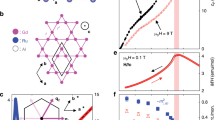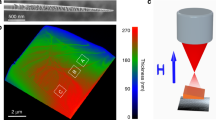Abstract
The skyrmion1,2,3,4, a vortex-like spin-swirling object, is anticipatedto play a vital role in quantum magneto-transport processes such as the quantum Hall and topological Hall effects3,5,6. The existence of the magnetic skyrmion crystal (SkX) state was recently verified experimentally for MnSi and Fe0.5Co0.5Si by means of small-angle neutron scattering7,8 and Lorentz transmission electron microscopy9. However, to enable the application of such a SkX for spintronic function, materials problems such as a low crystallization temperature and low stability of SkX have to be overcome. Here we report the formation of SkX close to room temperature in thin-films of the helimagnet FeGe. In addition to the magnetic twin structure, we found a magnetic chirality inversion of the SkX across lattice twin boundaries. Furthermore, for thin crystal plates with thicknesses much smaller than the SkX lattice constant (as) the two-dimensional SkX is quite stable over a wide range of temperatures and magnetic fields, whereas for quasi-three-dimensional films with thicknesses over as the SkX is relatively unstable and observed only around the helical transition temperature. The room-temperature stable SkX state as promised by this study will pave a new path to designing quantum-effect devices based on the controllable skyrmion dynamics.
This is a preview of subscription content, access via your institution
Access options
Subscribe to this journal
Receive 12 print issues and online access
$259.00 per year
only $21.58 per issue
Buy this article
- Purchase on Springer Link
- Instant access to full article PDF
Prices may be subject to local taxes which are calculated during checkout



Similar content being viewed by others
References
Skyrme, T. A unified field theory of mesons and baryons. Nucl. Phys. 31, 556–569 (1962).
Rajaraman, R. Solitons and Instantons 115–123 (Elsevier, 1987).
Sondhi, S. L., Karlhede, A., Kivleson, S. A. & Rezayi, E. H. Skyrmions and the crossover from the integer to fractional quantum Hall-effect at small Zeeman energies. Phys. Rev. B 47, 16419–16426 (1993).
Bogdanov, A. N. & Yablonskiî, D. A. Thermodynamically stable ‘vortics’ in magnetically ordered crystals: The mixed state of magnets. Sov. Phys. JETP 68, 101–103 (1989).
Neubauer, A. et al. Topological Hall effect in the A phase of MnSi. Phys. Rev. Lett. 102, 186602 (2009).
Lee, M., Kang, W., Onose, Y., Tokura, Y. & Ong, N. P. Unusual Hall anomaly in MnSi under pressure. Phys. Rev. Lett. 102, 186601 (2009).
Mühlbauer, S. et al. Skyrmion lattice in a chiral magnet. Science 323, 915–919 (2009).
Münzer, W. et al. Skyrmion lattice in a doped semiconductor. Phys. Rev. B 81, 041203 (2010).
Yu, X. Z. et al. Real-space observation of a two-dimensional skyrmion crystal. Nature 465, 901–904 (2010).
Hsieh, D. et al. Observation of unconventional quantum spin textures in topological insulator. Science 323, 919–922 (2009).
Moore, J. E. The birth of topological insulators. Nature 464, 194–198 (2010).
Onoda, M., Tatara, G. & Nagaosa, N Anomalous Hall effect and skyrmion number in real and momentum spaces. J. Phys. Soc. Jpn 73, 2624–2627 (2004).
Binz, B. & Vishwanath, A. Chirality induced anomalous-Hall effect in helical spin crystals. Physica B 403, 1336–1360 (2008).
Yi, S. D., Onoda, S., Nagaosa, N. & Han, J. H. Skyrmions and anomalous Hall effect in a Dzyaloshinskii–Moriya spiral magnet. Phys. Rev. B 80, 054416 (2009).
Brataas, A., Bauer, G. E. W. & Kelly, P. J. Non-collinear magnetoelectronics. Phys. Rep. 427, 157–255 (2006).
Dzyaloshinsky, I. A thermodynamic theory of ‘weak’ ferromagnetism of antiferromagnetics. J. Phys. Chem. Solids 4, 241–255 (1958).
Moriya, T. Anisotropic superexchange interaction and weak ferromagnetism. Phys. Rev. 120, 91–98 (1960).
Grigoriev, S. V. et al. Crystal handedness and spin helix chirality in Fe1−xCoxSi. Phys. Rev. Lett. 102, 037204 (2009).
Ishikawa, Y., Tajima, K., Bloch, D. & Roth, M. Helical spin structure in manganese silicide MnSi. Solid State Commun. 19, 525–528 (1976).
Tanaka, M., Takayoshi, H., Ishida, M. & Endoh, Y. Crystal chirality and helicity of the helical spin density wave in MnSi I. Convergent-beam electron diffraction. J. Phys. Soc. Jpn 54, 2970–2974 (1985).
Lebech, B., Bernhard, J. & Freltoft, T. Magnetic structures of cubic FeGe studied by small-angle neutron scattering. J. Phys. Condens. Matter 1, 6105–6122 (1989).
Rößler, U. K., Bogdanov, A. N. & Pfleiderer, C. Spontaneous skyrmion ground states in magnetic metals. Nature 442, 797–801 (2006).
Ishizuka, K. & Allman, B. Phase measurement of atomic resolution image using transport of intensity equation. J. Electron Microsc. 54, 191–197 (2005).
Uchida, M. et al. Topological spin textures in the helimagnet FeGe. Phys. Rev. B 77, 184402 (2008).
Uchida, M., Onose, Y., Matsui, Y. & Tokura, Y. Real-space observation of helical spin order. Science 311, 359–361 (2006).
Egerton, R. F. Electron Energy-loss Spectroscopy in the Electron Microscope 301–312 (Plenum Press, 1996).
Acknowledgements
We would like to thank N. Nagaosa, T. Arima, Y. Kaneko, Y. Taguchi, K. Ishizuka and T. Hara for helpful discussions. This work was partly supported by the Nanotechnology Network Project (No. ADE21005) and Grant-in-Aids for Scientific Research (No. 20340086, 20046004 and 22014003) from the Ministry of Education, Culture, Sports, Science and Technology of Japan, and also by the Funding Program for World-Leading Innovative R&D on Science and Technology (FIRST Program).
Author information
Authors and Affiliations
Contributions
X.Z.Y. carried out the Lorentz TEM observations, performed the high-resolution spin texture in the skyrmion lattice and prepared the manuscript. N.K., Y.O. and S.I. prepared the polycrystalline sample and wrote part of the method and discussion sections. W.Z.Z. prepared the TEM sample. K.K. contributed to the EELS analyses. Y.M. contributed to the discussion and assisted in writing the discussions. Y.T. contributed to planning of the study and writing of the manuscript.
Corresponding authors
Ethics declarations
Competing interests
The authors declare no competing financial interests.
Supplementary information
Supplementary Information
Supplementary Information (PDF 791 kb)
Rights and permissions
About this article
Cite this article
Yu, X., Kanazawa, N., Onose, Y. et al. Near room-temperature formation of a skyrmion crystal in thin-films of the helimagnet FeGe. Nature Mater 10, 106–109 (2011). https://doi.org/10.1038/nmat2916
Received:
Accepted:
Published:
Issue Date:
DOI: https://doi.org/10.1038/nmat2916
This article is cited by
-
Stable skyrmion bundles at room temperature and zero magnetic field in a chiral magnet
Nature Communications (2024)
-
Dzyaloshinskii-Moriya interactions, Néel skyrmions and V4 magnetic clusters in multiferroic lacunar spinel GaV4S8
npj Computational Materials (2024)
-
Dipolar skyrmions and antiskyrmions of arbitrary topological charge at room temperature
Nature Physics (2024)
-
The influence of chiral arrangement in the magnetocaloric and thermoelectric properties of the intermetallic CeMn2Si2 compound: a first-principle and Monte Carlo simulation
Indian Journal of Physics (2024)
-
Controllable nucleation and deformation of skyrmions on surface of magnetic nanotubular monolayer
Rare Metals (2024)



